1814 Guadalajara 1 Real: A Die Variety Study
by Douglas Reil
This study focuses on the 1814 Guadalajara 1 real, minted in the third year of operation of this provisional Mexican mint. The dies at the provisional mints were notoriously crude and many corners were cut in the development of new dies from year to year. While this is certainly true of the coinage minted at Guadalajara, the 1814 1 real coins seem to be comparatively well made. But after closer study of multiple pieces, it is clear that there are some significant variations in the dies used.
It should be noted that the conclusions drawn here are based on the study of coins observed. It is very possible that additional varieties and marriages for this date/year combination have yet to be discovered. As more examples are examined, a more definitive picture of the varieties for this date year will become available.
After the study of multiple occurrences over a number of years, I have concluded that there were four die sets created for the minting of the 1814 Ga 1 real coins. These were indeed sets, as there seems to have only been one marriage of each obverse and reverse die. This could be explained by the dies at the provisional mints not always being created with exacting standards, especially in the annealing, or hardening process. If the dies were deteriorating with striking, it is very possible obverse and reverse dies were discarded together, and two new dies were then used going forward. It will be interesting to see if a new marriage of the dies in the study appears at some point, but the evidence suggests obverse and reverse dies were used as a set or single marriage.
Obverse Variations
The obverse die variations center on the dots or stops between the different elements of the legend. Even factoring in wear, which can impact the appearance of this sort of feature, it is clear punches of different sizes were used to create the dots on the various dies. The punches used result in dot sizes of small, medium, and large. And on one die, a dot was omitted creating a more obvious variety. And the last major obverse die variation is seen with the date: on one die, the numeral one has a crossbar, creating a “T” effect. There are other more minor variations seen in the legend and date, but the dots are the easiest way to differentiate between the various dies.
Reverse Variations
There are two attributes of the reverse that clearly vary between each die, allowing for easy attribution. The first is the crown over the shield. There are two obvious sizes, referred to as large and small in this study. But the large crown has three clear variations, with the easiest comparison being the jewels in each. One large crown contains only three jewels while the other two large crown varieties contain five jewels in different arrangements. The other clear crown variety is a small crown: this can be easily identified as the outer edges of the crown do not extend beyond the border of the shield. It should be noted that a small crown also appears on reverse of the 1815 Guadalajara 1 real, though on a different die than is used for coining the 1814 pieces.
The other difference to be used for attribution is the denomination, particularly the distance between the 1 and the R. Each variety has a very different alignment of the two characters, ranging from having them touching to increasingly further apart.
The Varieties
Variety 1
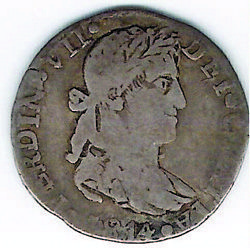

Obverse: five large dots
Reverse: large crown, five uneven jewels/ 1R touching
The obverse features very large dots or stops. This could be explained by the use of punches that were meant for the 2 reales dies, which when compared to this variety, look very similar. The reverse features a large crown, but the jewels are uneven, in a 2/3 alignment. The jewels themselves are not uniformly shaped, but present in different shapes, unlike the other five jewel large crown variety. This variety also has the 1 and R of the denomination clearly touching.
Variety 2
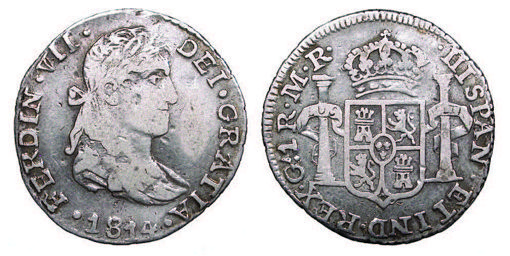 Obverse: five medium dots
Obverse: five medium dots
Reverse: large crown, five even jewels/ 1R far
The obverse features medium sized dots, rightly sized for the denomination. Also note the defective V in the ordinal, which looks to be a repunch. This is the only obverse die observed with a defective ordinal. The reverse has a large crown, but the jewels are evenly punched and are roughly the same, diamond shape. The characters in the denomination are separated noticeably, though not nearly as distant as variety 4. (Variety 2 images courtesy of Civitas Galleries)
Variety 3


Obverse: four dots
Reverse: large crown, three jewels/ 1R close
This variety has very clear attributes on both the obverse and reverse that make for easy identification. On the obverse, there are only four dots, with usual dot three above the king’s head missing. On the reverse, the large crown contains only three evenly spaced jewels. The 1R are spaced properly, close, but not touching.
Variety 4
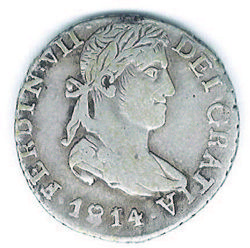
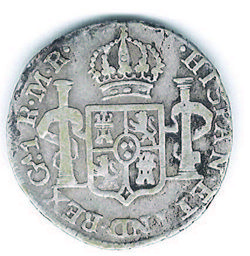
Obverse: five small dots/ “crossbar 1”
Reverse: small crown, three jewels/ 1R distant
Variety 4 notes: The obverse features very small dots, possibly created with the punch intended for creation of half real dies. But the primary obverse attribution feature is the so-called “crossbar 1”. This is visible even on low grade examples and clearly identifies this variety. One other element to check during attribution is the fifth I of the obverse legend: on this die, the I is touching the base of the bust. With the reverse, we find the only usage of the small crown and the denomination characters are distant, the furthest apart of any variety.
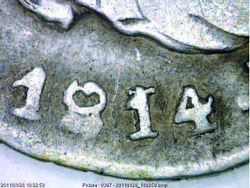
Variety 4: “crossbar 1” detail
Crown Comparison
Following is a side by side comparison of the reverse crowns.
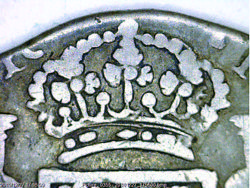
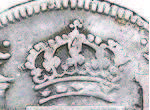
Variety 1: Large Crown/ 5 uneven jewels Variety 2: Large Crown/ 5 even jewels
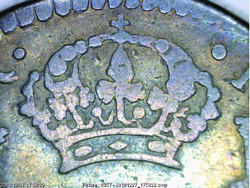
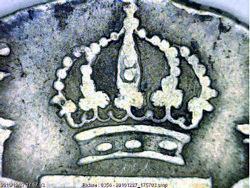
Variety 3: Large Crown/3 jewels Variety 4: Small Crown
Denomination Comparison
Following is a side by side comparison of the denominations to show variances.
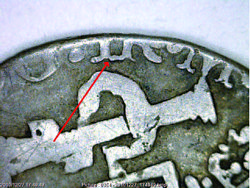

Variety 1: 1R touching Variety 2: 1R far
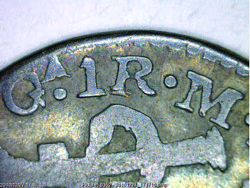
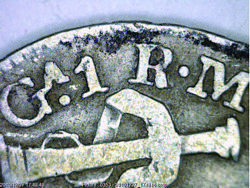
Variety 1: 1R close Variety 2: 1R distant
To summarise
| Variety | Obverse | Reverse | Denomination |
| Variety 1 | 5 large dots | Large crown/ 5 uneven jewels | 1R touching |
| Variety 2 | 5 medium dots | Large crown/ 5 even jewels | 1R far |
| Variety 3 | 4 dots | Large crown/ 3 jewels | 1R close |
| Variety 4 | 5 small dots/ "crossbar 1" | Small crown/ 3 jewels | 1R distant |
A note on rarity
According to Guadalajara mint records as presented in Pradeau’s Numismatic History of Mexico, the 1814 1 real had the lowest mintage of all silver denominations that year with just over 12,000 pieces. Looking at the number of occurrences of each variety, the numbers come in very close to even for varieties 1, 3, and 4. There were slightly fewer occurrences of variety 2, making it the rarest variety of a scarce issue based on the observed population. More examples will need to be seen before any conclusions on rarity can be made.
